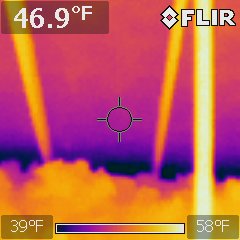Thermal Imaging
A thermal imaging camera, also known as an infrared camera, captures infrared radiation emitted by objects to create images based on temperature variations. This equipment allows the user to see water leaks, insulation defects or air infiltration that would otherwise be invisible to the naked eye. Our inspectors are equipped with thermal imaging cameras that can identify problems or defects that may otherwise go undetected.
All home inspections include the use of a thermal imaging camera where necessary to identify or diagnose concealed conditions.
Advantages of a thermal imaging inspection include:
Early Issue Detection: Identify hidden issues such as insulation gaps, electrical hotspots, and moisture intrusion before they escalate.
Energy Efficiency: Pinpoint areas of energy loss in buildings, helping to optimize insulation and reduce utility costs.
Electrical System Assessment: Detect overheating in electrical components, preventing potential fire hazards and equipment failures.
Moisture Detection: Identify moisture-related issues, preventing mold growth, structural damage, and potential health hazards.
Building Performance: Evaluate the performance of HVAC systems, identify air leaks, and ensure proper ventilation.
Time Efficiency: Swiftly assess large areas for potential issues without invasive measures, saving time and resources.
Preventative Maintenance: Proactively address issues, reducing the risk of major repairs and extending the lifespan of building components.
Non-Invasive: Conduct inspections without disrupting structures, making it a non-intrusive diagnostic method.
Comprehensive Insight: Provide a comprehensive understanding of a building’s condition, allowing for informed decision-making.
Environmental Impact: Contribute to environmental sustainability by optimizing energy usage and reducing waste through targeted repairs.

